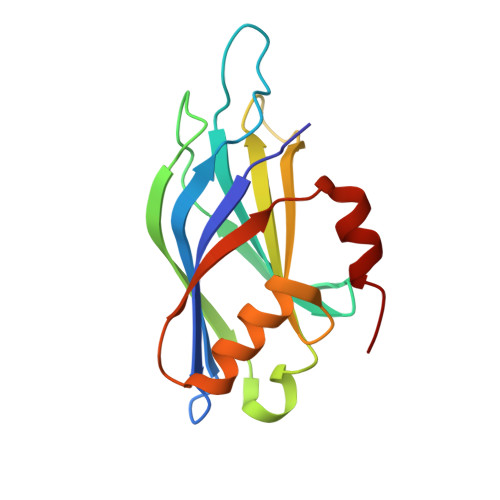Non-Native Metal Ion Reveals the Role of Electrostatics in Synaptotagmin 1-Membrane Interactions.
Katti, S., Nyenhuis, S.B., Her, B., Srivastava, A.K., Taylor, A.B., Hart, P.J., Cafiso, D.S., Igumenova, T.I.(2017) Biochemistry 56: 3283-3295
- PubMed: 28574251
- DOI: https://doi.org/10.1021/acs.biochem.7b00188
- Primary Citation of Related Structures:
5T0R, 5T0S - PubMed Abstract:
C2 domains are independently folded modules that often target their host proteins to anionic membranes in a Ca 2+ -dependent manner. In these cases, membrane association is triggered by Ca 2+ binding to the negatively charged loop region of the C2 domain. Here, we used a non-native metal ion, Cd 2+ , in lieu of Ca 2+ to gain insight into the contributions made by long-range Coulombic interactions and direct metal ion-lipid bridging to membrane binding. Using X-ray crystallography, NMR, Förster resonance energy transfer, and vesicle cosedimentation assays, we demonstrate that, although Cd 2+ binds to the loop region of C2A/B domains of synaptotagmin 1 with high affinity, long-range Coulombic interactions are too weak to support membrane binding of individual domains. We attribute this behavior to two factors: the stoichiometry of Cd 2+ binding to the loop regions of the C2A and C2B domains and the impaired ability of Cd 2+ to directly coordinate the lipids. In contrast, electron paramagnetic resonance experiments revealed that Cd 2+ does support membrane binding of the C2 domains in full-length synaptotagmin 1, where the high local lipid concentrations that result from membrane tethering can partially compensate for lack of a full complement of divalent metal ions and specific lipid coordination in Cd 2+ -complexed C2A/B domains. Our data suggest that long-range Coulombic interactions alone can drive the initial association of C2A/B with anionic membranes and that Ca 2+ further augments membrane binding by the formation of metal ion-lipid coordination bonds and additional Ca 2+ ion binding to the C2 domain loop regions.
Organizational Affiliation:
Department of Biochemistry and Biophysics, Texas A&M University , 300 Olsen Boulevard, College Station, Texas 77843, United States.
















